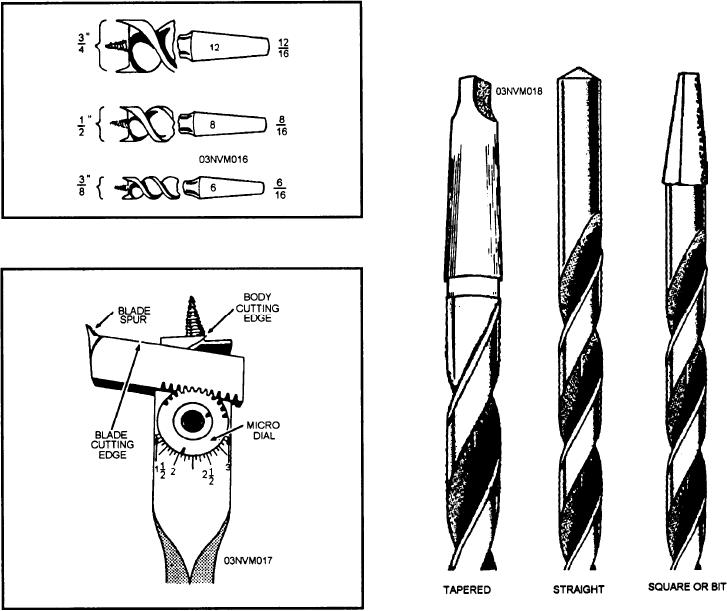expansive, bit (fig. 5-17). The expansion bit consists
The shank is that part of the auger bit that fits into
of a screw point, the body cutting edge, and three
the chuck of the brace. It has the drill size number
adjustable cutter blades. The blades let you bore holes
stamped on one of the flats of the square-tapered tang.
up to 4 inches in diameter. The adjustable cutter blade
This number represents the drill size in sixteenths of an
adjusts by either a microdial (fig. 5-17) or a simple
inch (fig. 5-16). For instance, if the number stamped on
screw arrangement. Make a trial cut on scrap stock
the flat is 12, the drill size is 12/16 inch or 3/4 inch. All
after adjusting an expansion bit to make sure that the
bits having a tang-type shank are numbered and sized
bit is cutting the exact diameter desired.
in this manner.
Auger bits usually come in sets containing 1/4-inch
TWIST BIT
(#4) to 1-inch (#16) bits, but they are available up to 2
inches (#32) in diameter. Many different lengths of
The twist drill bit (fig. 5-13, view C) is used to bore
auger bits are available and come in three sizes. The
holes 1/2 inch and under. They work with any type of
dowel bit is about 5 inches long. The medium bit is
drill. High-carbon or high-speed steel twist drills are
about 8 inches long and the ship bit is from 18 to 24
used for low-speed metal boring or high-speed wood
inches long. The medium bit is the length most com-
boring. The high-speed steel drill is for high-speed
monly used.
metal boring.
EXPANSION BIT
Twist drills come in several styles. The styles are
differentiated by the shank. The part of the twist drill
Another bit designed for use with the brace and to
that fits into the socket, spindle, or chuck of the drill
bore holes larger than 7/8 inch is the expansion, or
press is known as the shank. The three most common
types of shanks are shown in figure 5-18.
Figure 5-16.--Size markings on auger bits.
Figure 5-17.--Expansion bit.
Figure 5-18.--Three most common types of shanks.
5-11






